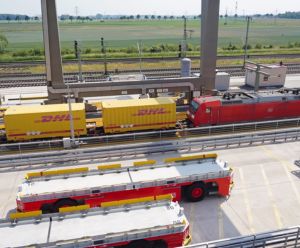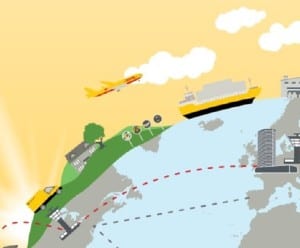
Navigating the sea of uncertainty with multimodal logistics

For almost a decade, stability and continuity in global trade meant a smooth-sailing journey for logistics and shipping. But geopolitical tensions, weather disruptions, fiscal pressures, and regulatory ambiguities have all threatened the stability of the global supply chain.
The past few years have seen a slew of black swan events capsizing the stability of global supply chains worldwide. Even as we were en route to recovery from the global pandemic, the war in Europe, the Gaza Strip, and attacks on vessels in the Red Sea have created a truly volatile, uncertain, complex, and ambiguous (VUCA) world, far from what we consider normal.
The economic impact of supply chain disruptions is colossal, with a 2021 survey revealing that they cost organizations an average of US$184 million (€169 million) annually. Being heavy on import and export, the United States (U.S.) was the most severely impacted, with the estimated average annual cost of respondents' organizations amounting to US$228 million (€211 million).
Covid-19 was the biggest culprit behind this hefty financial cost, with 72 percent of respondents in a 2022 survey stating that the pandemic had negatively affected their businesses. Despite the pandemic’s immediate economic impact, it also accelerated the adoption of innovations and solutions that improved the agility and resilience of supply chains.
Of the solutions that arose, multimodal logistics stands out for its simple yet effective premise of shoring up the resilience of global supply chains and mitigating the risks associated with disruptions.
Parting the Red Sea with multimodal logistics
Multimodal logistics integrates multiple modes of transportation to move goods from one point to another. Administered and coordinated under one provider, multimodal logistics encompasses a mixture of air, ocean, road, and rail freight.
With this approach, businesses enjoy greater efficiency as they combine the strengths of different modes of transport to deliver their cargo. While trucks provide speed and maneuverability over short distances, ships offer reduced carbon emissions for long-distance ocean freight compared to planes.
In late 2023, shipping disruptions in the Red Sea impacted routes with vantage points in the Asia-Pacific. Sending goods through the Red Sea had become risky. Diverting ships around the entire African continent would have meant longer transit times and the use of faster air freight would have increased costs.
The disruptions caused by the Red Sea prompted a major sporting brand to reach out to DHL with a critical request to deliver their stocks — a task made especially challenging by the high volumes during the tail end of the peak season.
To keep shoes and apparel moving into stores, the DHL Customer Solutions & Innovation (CSI) team partnered with DHL Global Forwarding to set up a rail solution, taking on the sportswear previously slated for ocean freight.
Having already served shipments with the rail alternative before and during the pandemic, DHL Global Forwarding had established a strong partnership with rail teams from different countries. This enabled the DHL Global Forwarding team to handle the request with weekly block trains booked exclusively for the sporting brand customer, fulfilling the brand’s demand to ship 35 to 41 containers weekly from factories in Asia (Vietnam, Cambodia, and China) to final destinations in Germany and the United Kingdom (U.K.).
Taking to the skies for the last mile
Aside from end-to-end logistics, multimodal logistics have also been effectively deployed in last-mile deliveries, where time is of the essence in ensuring that goods are physically delivered to their recipients quickly and efficiently.
Consider the typical urban area, where traffic congestion is a key cause of delayed deliveries. While trucks are great for long-distance deliveries, traffic congestion can cause them to spend up to 60 percent of their time immobile. This is where switching to smaller, more compact vehicles like vans or even motorcycles is useful, as they can thread through the traffic and complete the remainder of the journey.
The versatility in switching between different modes of transport builds the overall supply chain’s resilience in the long run. With the single point of failure eliminated using multiple transport options, businesses can easily reroute their shipments when disruptions arise.
Sustainability and efficiency, all in one
Aside from building supply efficiency and resilience, multimodal logistics also reduce the supply chain’s carbon footprint. As different modes of transportation have varying environmental footprints, businesses can select the most fuel-efficient options for specific segments of their freight transportation journeys. This was the case with Nokia, which utilized DHL Global Forwarding’s Multimodal Express (MMEX) solution to transform its supply chain between China and Curitiba, Brazil.
Initially relying on air freight for its entire supply route, Nokia added ocean and road freight to its process through MMEX. Under this refreshed system, the first segment of the journey from China to Los Angeles is performed via ocean freight. When the shipments reach Los Angeles, trucks will transport them to Miami, and airplanes will deliver them to South America.
This switch to MMEX enabled Nokia to reduce its carbon emissions by at least 68 percent without significantly increasing its transit time during the transition.
Additionally, multimodal logistics can improve carbon efficiency without compromising on transport efficiency. This has been realized through a collaboration between U.S.-based cranberry producer Ocean Spray, rail operator CSX, and fruit-shipping companies, where an intermodal rehaul from road to rail led to a 20 percent reduction in carbon emissions. The cost of transportation was also significantly reduced by at least 40 percent.
Implement multimodal logistics the right way
Amid the ever-changing state of the world, the astute business builds its resilience with the flexibility to reshape its supply chain with multimodal logistics.
Businesses must determine an optimal combination of transport modes and routes, which inevitably involves a rigorous analysis of key considerations like distance, urgency, and costs. They must also account for potential disruptions and adjust their strategy accordingly.
They must also meticulously document the end-to-end supply journey, especially since multimodal shipments involve transfers between different entities. To this end, companies should integrate with digital platforms to buffer the documentation process, ensuring real-time visibility, smooth customs clearances, and reduced delay risks. Such technological integrations will also enable businesses to track their shipments across every step of the supply journey.
Finally, businesses must forge robust relationships with reliable transportation providers and coordinate their delivery schedules and routes to optimize the entire supply journey from end to end. By strategically combining various transport methods, businesses set themselves up for success as they simultaneously build resilience into their supply chains and maintain cost-effectiveness and efficiency.
ALSO WORTH READING













 English
English